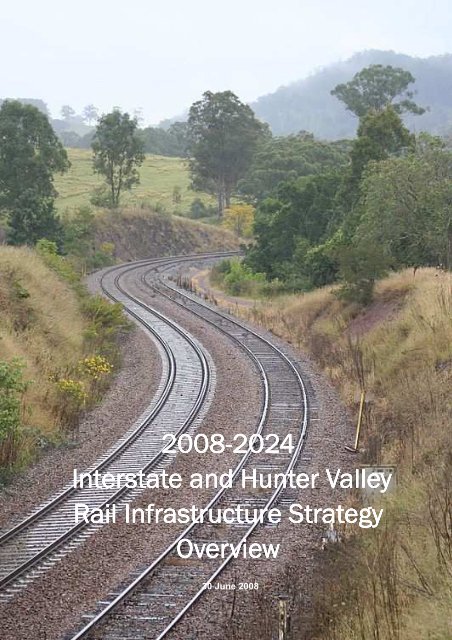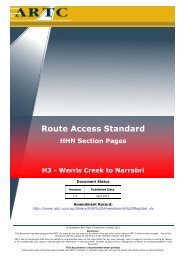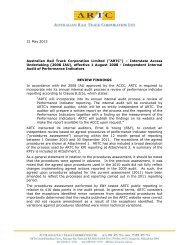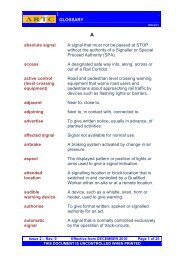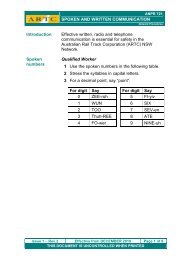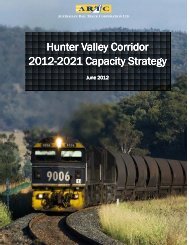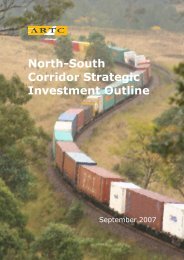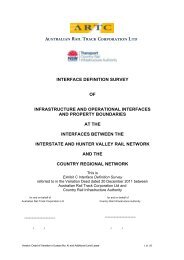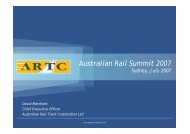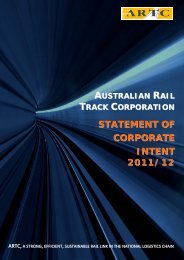Create successful ePaper yourself
Turn your PDF publications into a flip-book with our unique Google optimized e-Paper software.
2008-20242024Interstate and Hunter ValleyRail Infrastructure StrategyOverview30 June 2008
11<strong>ARTC</strong> BackgroundLand transport is one of the most significant elementsaffecting the Australian economy.Traditionally, rail has performed well in the transportationof bulk commodities, but poorly in the intermodalsector.Although there has been some turn around, particularlyon the East-West corridor, there is still a need for railto develop into a more viable logistics option for the Australianmarket.Critical to this is the ongoing development of the Melbourne-Sydneyand Sydney-Brisbane corridors.These are tough corridors with significant topographicaland other land management constraints; road hastraditionally had an advantage on this route.Introductionhas not been maintained at a level necessary to make itattractive to the market; transit times have been too slow,train lengths too short and reliability has been poor..All assessments are that the Australian logistics marketis going to double over the next 15-20 years. At present,it will be virtually impossible for road infrastructuredevelopment to keep pace with this massive level ofgrowth.It is therefore essential that rail plays a much greaterrole in adding value to the Australian logistics framework.The ongoing challenge is to breathe new life into the nation’srail system, elevating it to a standard where themarket considers it an efficient, reliable and preferredmode of freight transport.The focus of this submission is on the interstate standardgauge network connecting the port and key terminalinfrastructure of Brisbane, Melbourne, Adelaide, Sydneyand Perth and the adjacent Hunter Valley network.Further to this, the rail infrastructure on this corridor2008-2024 NETWORK—WIDE INFRASTRUCTURE STRATEGY <strong>OVERVIEW</strong>
• The difficulty of using public private partnershipsfor funding rail capital works due to the complexityof rail infrastructure.4In addition to infrastructure development there are anumber of structural matters that may limit rail’s ability tosupport an expanded freight task.The following key areas of policy will support railgrowth:• Mechanisms to price the effect of external impacts,such as carbon pricing, will deliver better socialoutcomes, and are likely to favour rail transport.• Increased commercialisation of the road sector,with Government intervention to address areas ofinequity including a mass distance pricing regimefor heavy vehicles will promote efficient resourceallocation and is likely to favour rail transport.• Commercially balanced, light-handed economicregulation and a national approach to safety regulation,will promote timely investment and efficientand responsive rail operations.• Integrated land-use / transport planning that recognisesand reinforces the role of rail will assist railcompetitiveness.• Support for mechanisms to encourage investmentin long life above rail assets, including rollingstockand locomotives, that will in time to deliver economicand environmental benefits.2008-2024 NETWORK—WIDE INFRASTRUCTURE STRATEGY <strong>OVERVIEW</strong>
54Existing Infrastructure & Future ProjectsThe rail industry has in place a number of strategies toaddress existing and some short term bottlenecks.<strong>ARTC</strong> both invests its own funds, and receives occasionalfunding from the Australian Government, through programssuch as AusLink.In its proposal to the NSW Government for the lease of theNSW interstate and Hunter Valley network <strong>ARTC</strong> proposedan investment program of $872 million, fully funded by<strong>ARTC</strong> on a commercial basis. This investment was primarilydirected at addressing long standing maintenance issueand improving the efficiency and competitiveness of theNorth-South corridor.In the years following the commencement of the <strong>ARTC</strong>lease <strong>ARTC</strong> received contributions from the AustralianGovernment and added its own additional funding. Theresulting investment is described in the document North-South Corridor Strategy [copy attached].<strong>ARTC</strong>’s investment program North-South now stands at$2.1 billion and is aimed at achieving the following outcomes:Melbourne -SydneySydney -BrisbaneMelbourne -BrisbaneTransit Time Hours Hours Hours2005 13.5 19.4 32.92010 (1500 m) 10.5 15.1 25.62010 (1800 m) 11.6 15.1 26.7Reliability % % %2005 55 55 452010 75 75 75Availability % % %2005 50 35 602010 75 60 85<strong>ARTC</strong>’s current 5-year investment program was commencedin 2005 and will be largely completed by June2009. The current scope of this program is provided below:Melbourne - Sydney (Figure 1)• Concrete sleepering of the entire <strong>ARTC</strong> trackbetween Melbourne and Sydney.• Southern Sydney Freight Line. This is the constructionof a dedicated freight track betweenChullora and Macarthur in Sydney’s south.• Installation of Automatic Signalling on sections oftrack south of Sydney.• Overtaking loop on the double track at Harden.• Seven passing lanes and two loop extensionsJunee – Melbourne.• Conversion of broad gauge track between Seymour– Wodonga to create double track.• Single track bypass of Wodonga town centre.• Establishment of a triangle at Tottenham to providea direct connection between the North-South and East-West corridors.• Upgrade of the dual section between Tottenhamand Dynon rail freight terminal.• Replacement of Murrumbidgee River Bridge,Wagga Wagga.Sydney - Brisbane (Figure 2)• Concrete sleepering between Sydney and theQueensland border.• An approximate doubling of the number of longpassing loops on the North Coast.• Installation of the Centralised Traffic Control(CTC) signalling between Casino and AcaciaRidge.• Loop upgrades between Newcastle and AcaciaRidge2008-2024 NETWORK—WIDE INFRASTRUCTURE STRATEGY <strong>OVERVIEW</strong>
6Figure 1 -Figure 2 -2008-2024 NETWORK—WIDE INFRASTRUCTURE STRATEGY <strong>OVERVIEW</strong>
7Train Control Consolidation (figure 3)This recently completed project, aligns with the North—South investment upgrade and combines physical projectswith work process changes designed to significantly improvetrain control delivery.Key physical projects included the replacement of oldsignal technology with new on two sections of the MainSouth, closure of signal boxes controlling yards at 10 locations,and the upgrade of the two key train control centresto Network Management Centres.Figure 3 -Figure 4 -2008-2024 NETWORK—WIDE INFRASTRUCTURE STRATEGY <strong>OVERVIEW</strong>
East-West Upgrades (Figure 4 & 5)<strong>ARTC</strong> is also continuing to invest in the east-west corridorto maintain its competitiveness. Significant recent andongoing projects are:• Increasing the height clearance for trains to6500 mm to allow double-stacked containers tobe carried between Parkes and Perth.• Passing loop extensions for 1800 metre trains atKinalung and Matakana.• <strong>ARTC</strong>’s innovative In Cab Automated Points Sys-tem (ICAPS) technology has been rolled-outacross the Port Augusta - Kalgoorlie corridor toallow train drivers to enter loops without stopping.• Construction of a third track along the length ofthe Minimbah Bank starting from the north ofWhittingham Junction.• Newdell Junction and Drayton Junction upgrades• Antienne to Muswellbrook duplication will extendthe existing double track• Installation of the Ulan line Centralised Train Controldigital signal technology.• Construction of up to six new passing loops on theUlan line.• Additional and extended passing loops betweenMuswellbrook and Werris Creek• Two sets of projects are planned for the WerrisCreek – Narrabri line which is currently part of the8Figure 5 -Hunter Valley (Figure 6 & 7)<strong>ARTC</strong>’s 5 year investment program in the Hunter Valleynow stands at over $1.0 billion. The Hunter Valley programis funded commercially by <strong>ARTC</strong> subject to industrycommitment to the program. The investment includes theprojects detailed below . This is detailed in the HunterValley Corridor 2007—2012 Capacity Strategy:NSW Country Regional Network managed by <strong>ARTC</strong>on behalf of the NSW Government. The projectsare:1. CTC to replace the electric staff system.2. Extension of up to 8 loops to provide additionalcapacity.• Sandgate overbridge between coal trains accessingKooragang Island and the Sydney – Brisbanemain line• Bidirectional signaling (signals on both tracks inboth directions) between Maitland and Branxton2008-2024 NETWORK—WIDE INFRASTRUCTURE STRATEGY <strong>OVERVIEW</strong>
9Figure 6 -Figure 7 -Current AusLink ProjectsThe Australian Government has made a further $550million available for projects associated with rail freightacross Australia under AusLink 1. Key Auslink 1 projectsassociated with the interstate and Hunter Valley networkinclude:• $20.3 million for development of the <strong>ARTC</strong> AdvancedTrain Management System (ATMS) toprovide a new train control and safeworkingsystem for the interstate and Hunter Valley network.• $4.7 million for the Ernst and Young study intothe North-South Rail Corridor.• A $69.6 million contribution to the National TrainCommunications System.• $110 million for works to improve freight accessthrough northern Sydney and on the Port Botanyline.• $110 million for a new rail link from the Dynonintermodal precinct to the Port of Melbourne andthe upgrade and elevation of Footscray Road.• $80 million for the Port River Expressway andassociated rail track modifications, including anew direct connection to the Adelaide port area• $14 million to help construct a North Quay RailLoop extension at the Port of Fremantle, and anew access road to the terminal.• An $8 million contribution to the cost of extendingeight rail loops to 1800 metres on the interstateline between Kewdale and Kalgoorlie.• A $20.1 million contribution to the cost of replacingthe final 76km of timber-sleepered track withconcrete sleepers between Koolyanobbing andKalgoorlie.• $11.5 million towards the cost of eliminating theDaddow Road level crossing at Kewdale2008-2024 NETWORK—WIDE INFRASTRUCTURE STRATEGY <strong>OVERVIEW</strong>
105Demand Forecasts<strong>ARTC</strong> has developed an integrated and optimised programmeof projects for the next 15-years.The projects have been based around the followingprinciples:• Detailed intermodal volume projections have beenproduced based on scenarios around fuel prices, carbonprices and other key cost inputs. Coal and mineralsprojections have been developed based on producerforecasts.• Projects to enhance the efficiency of the rail networkshave been identified, and recommended implementationdates have been developed based on economicand financial analysis.• Projects have been identified to ensure capacityremains ahead of demand while maintaining servicelevels.As a general approach to infrastructure planning, <strong>ARTC</strong>takes a positive view of potential volume growth – thisallows projects to be identified and progressed in a timelymanner to ensure sufficient capacity in the event that theprojection of growth in demand is accurate. In the eventthat growth is not so fast, projects can be slowed downaccordingly.Until recently, <strong>ARTC</strong>’s projections of demand growthwere based on historical rates of growth plus 1% – 2%, anda broad continuation of historical rail market share, otherthan for the North-South Corridor where a significant marketshare increase was forecast following the completionof the North-South Corridor upgrade works.However it is possible that transport is facing a significantshift in its underlying costs that would result in a moresignificant growth environment. The key elements of thisnew environment are:• Continued rising fuel costs.• Continued rising labour costs, in particular forlong-distance truck drivers.• Introduction of a carbon trading scheme.• Introduction of mass-distance charging for roadtruck access.• Increased urban congestion.• Continued rising demand for NSW coal.• Continued rising demand for other Australianminerals.For the purposes of this Infrastructure Strategy <strong>ARTC</strong>has therefore considered it prudent to model a range ofscenarios that represent a departure from historicaltrends.More detail on the modelling methodology and assumptionsis provided in the paper Intermodal MarketAnalysis [copy attached].(All prices $2007/08)LowMediumHighOil Price (US$ / barrel)$80.00 $100.00 $150.00A$ / US$ Exchange Rate $0.85 $0.75 $0.65Carbon Price (A$ / tonne CO2)$25.00 $50.00 $100.00Labour CostsNo real change 25% real increase 50% real increaseRoad-User ChargesNo real change 50% real increase 100% real increaseTable 1 -2008-2024 NETWORK—WIDE INFRASTRUCTURE STRATEGY <strong>OVERVIEW</strong>
11Scenario Assumptions<strong>ARTC</strong>’s approach has been to postulate levels for keyinput costs as at 2017/18. This allows rail market share tobe predicted for that year and a compound rate of growthto reach that market share to be determined. Costs arethen held constant in real terms from 2017/18 to2023/24. It is important to note that the effect of the road/ rail relative price changes has been applied progressivelywith a lag of 5 years.The assumptions for the three scenarios are shown inTable 1.In all scenarios rail reliability and availability are assumedto improve significantly for the Melbourne – Sydney,Sydney – Brisbane and Melbourne – Brisbane corridorsin 2009/10 with the completion of the North-Southupgrade works. Otherwise reliability and availability areassumed to remain constant for all modes.It is important to note that while the oil price in the lowscenario is below current price levels, <strong>ARTC</strong> believes thatthe freight market has not yet responded to the recentdramatic increases in fuel costs. Accordingly, even the lowscenario will involve significant growth in rail volumes.Given the magnitude of the freight cost increases thathave already occurred, and the potential size of futurechanges, there is a very good prospect that the total size ofthe freight market will be impacted. <strong>ARTC</strong> has taken thisinto account in its modelling.<strong>ARTC</strong> is also cognisant that the effects of fuel pricingand other costs may lead to long term alterations to thesupply chain and logistics market. This has the potential inthe longer term to adjust the transport logistics of componentsfor goods from the present world market to morelocalized supply chains. <strong>ARTC</strong> doesn’t believe their structuralchange will have a significant impact in the 15 yearhorizon.Market Share and Volume OutcomesFigure 8 shows estimated rail market share in2004/05 (which has been taken as the base year as it isthe last year before the market was affected by significantcost increases), 2009/10, and under high, medium andlow scenarios in 2017/18. It should be noted that there isno allowance for lag in these estimates and the 2009/10market share in particular is not likely to reach this leveluntil some years afterwards.The notable feature of this data is the significant increasein market share captured by rail on the short andmedium haul routes.Even under the low scenario, rail is achieving marketshares of 30% - 40% on Melbourne – Sydney, Sydney –Brisbane and Sydney – Adelaide, and over 80% on Melbourne– Brisbane.Under the high scenario, which is potentially the mostplausible scenario in light of recent experience, rail isachieving around 60% market share on Melbourne – Sydney,Sydney – Brisbane and Sydney – Adelaide, and wellover 80% on Melbourne – Brisbane.Predicted Rail Market Share(unlagged)120%100%80%Current2009/10 Predicted2017/18 Low2017/18 Medium2017/18 HighMarket Share60%40%20%0%Melbourne -SydneySydney -BrisbaneMelbourne -BrisbaneMelbourne -AdelaideMelbourne -PerthSydney - Perth Sydney -AdelaideBrisbane -PerthBrisbane -AdelaideAdelaide -PerthFigure 8 -2008-2024 NETWORK—WIDE INFRASTRUCTURE STRATEGY <strong>OVERVIEW</strong>
126As a result of these demand forecasts a number of areason the interstate rail network will become constrained andwill not adequately cater for projected growth.The further major enhancements and capacity improvementprojects that <strong>ARTC</strong> wishes to pursue on the north-southcorridor over the next 15 years are as follows:Infrastructure Adequacypowered by Telstra’s 3G Network.• The north-south corridor would need to be upgradedto Advanced Train Management System from 2011,however, this relies on Government assistance. Thisinitiative would enhance capacity on the interstatemainline and around congested Port interfaces• Capacity enhancement through Northern Sydney.The line between Sydney and Newcastle, and inparticular the southern end of it, is recognised asthe major bottleneck on the north-south corridor.Freeing-up capacity in this area is key to rail increasingits levels of reliability and to presume adequatecapacity.• Development of a new multi-user intermodal terminalat Moorebank. This will remove the constraintsof the current limited terminal capacity and providea more efficient and better located option. It wouldalso facilitate the introduction of double-stackingout of Sydney.• Increased terminal capacity in Brisbane. <strong>ARTC</strong> isconcerned about existing intermodal terminal capacityin Brisbane and has not seen reliable plans forimprovement. Without this being addressed in theshort term this will become a major constraint tocapacity enhancement.• In common with the rest of the network, the Network-wideTrain Communications System will berolled-out across the north-south corridor over thenext 12 months. This will upgrade the in cab communicationsystems of locomotives, replacing themultiple state-based model with a single system• Development of passing lanes between Sydney –Brisbane• Double track Wodonga to Junee and Seymour toTottenham to provide full double track betweenSydney and MelbourneThe projected outcomes from the delivery of these worksis shown in the table below. In addition there are a numberof major strategic choices that need to be made, which include:• Inland Route: There is a long-standing proposal for anew route between Melbourne and Brisbane followinga corridor that remains to the west of the GreatDividing Range for as much of the distance as possible.This proposal is currently subject to a $15 millionstudy requested by the Australian Government.<strong>ARTC</strong> has not identified a compelling requirement topursue an Inland Route in the 15-year timeframe ofthis Strategy.• Double stacking Melbourne – Sydney. Clearing theMelbourne – Sydney line for double stacking wouldoffer a cost saving of 1.5% to 2.5% in the largestgeneral freight market, while providing significantadditional capacity. Economic analysis suggests thatthis project is justified in a 2015/16 timeframe.Melbourne -Sydney#Sydney -Brisbane*Melbourne -BrisbaneBrisbane -AdelaideCapacity (Superfreighter pairs per week)2009 10 8 16 22014 36 33 45 32019 59 67 64 42024 74 92 77 5Transit Time (Hours)Target 10.4 15.1 28.0 40.02009 1<strong>1.2</strong> 14.7 25.9 37.32014 10.1 14.2 24.8 36.12019 10.1 14.1 24.7 36.02024 10.2 15.0 25.7 37.3Reliability (% freight available on-time)2009 55% 55% 45% 45%2014 85% 75% 75% 75%2019 85% 85% 85% 85%2024 85% 85% 85% 85%# Transit time to Chullora in 2009 & to Moorebankthereafter.* Transit time to Chullora in all years.2008-2024 NETWORK—WIDE INFRASTRUCTURE STRATEGY <strong>OVERVIEW</strong>
13 East—WestThe major enhancements that <strong>ARTC</strong> wishes to pursueon the east-west corridor over the next 15 years are asfollows:• Increased train length Melbourne – Adelaide.Moving from the current corridor limit of 1500metres to 1800 metres would add both capacity,and efficiency to the corridor. There is a requirementfor a number of loops of less than 1500metres to be extended on this line. There is also asignificant number of existing “1500 metre” loopsthat are physically 1800 metres and can be madeto accommodate 1800 metres with relativelystraightforward signalling changes. These circumstancessuggest that 1800 metres is a logical andcost-effective strategy.• Double stacking Sydney – Parkes. Clearing theSydney – Parkes line for double stacking wouldallow both Sydney – Perth and Sydney – Adelaidetraffic to go to a double stacked container configuration.This would improve the capacity and efficiencyof the line. It would also complement theintroduction of double-stacking between Melbourneand Sydney.• Track upgrading western Victoria and Cootamundra– Parkes. Upgrading of these line sectionswould allow increases in speed and axle load. Thiswould increase efficiency and reduce transit time.• In common with the rest of the network, the Network-wideTrain Communications System will berolled-out across the east-west corridor over thenext x years.• It would be desirable to upgrade the east-westcorridor to Advanced Train Management Systemfrom 2011. This initiative would enhance capacityon the interstate mainline and around congestedPort interfaces.A number of initiatives are specifically targeted toincrease capacity including:• Provision of new and extended crossing loopsMelbourne and Adelaide.• Construction of additional crossing loops betweenAdelaide and Perth.• Crossing loop extensions and control system upgradesbetween Cootamundra and Crystal Brook• Grade separation of Torrens and Goodwood Junctionsin AdelaideThe projected outcomes from the delivery of theseworks is shown in the table below. In addition there are anumber of major strategic choices that need to be made,which include:This Strategy does not make provision for doublestackingbetween Melbourne and Adelaide in its 15-yeartimeframe. While <strong>ARTC</strong> sees this as a desirable longertermgoal, economic analysis suggests that it is not requireduntil present scenarios during the next 15 years.The Strategy also does not make provision for an AdelaideHills bypass, which is an option for achieving doublestackingand also offers some other operational benefits.Such a bypass requires further research and may be justifiedfor reasons not directly associated with rail performance.In the event that Government decided to pursue abypass, it may bring forward the time at which implementationof double-stacking is economically justified.Melbourne -PerthMelbourne -Perth ExpressSydney - Perth#Sydney - PerthExpressMelbourne -AdelaideAdelaide - PerthSydney -AdelaideCapacity (Superfreighter pairs per week)2009 11 2 6 5 3 5 42014 11 3 6 5 7 5 82019 14 3 7 6 12 6 152024 16 3 8 7 17 7 19Transit Time (Hours)Target 58.0 50.0 74.0 50.0 12.0 42.5 28.02009 55.7 47.7 54.3 52.3 11.6 41.1 22.62014 55.3 47.3 53.8 51.8 11.5 40.8 21.42019 55.7 47.7 54.4 52.4 11.5 4<strong>1.2</strong> 21.42024 56.5 48.5 55.3 53.3 11.8 41.7 21.8Reliability (% freight available on-time)2009 75% 80% 80% 80% 55% 80% 55%2014 75% 80% 80% 80% 55% 80% 85%2019 75% 80% 80% 80% 55% 80% 85%2024 75% 80% 80% 80% 55% 80% 85%# Train Numbers include Parkes - Perth2008-2024 NETWORK—WIDE INFRASTRUCTURE STRATEGY <strong>OVERVIEW</strong>
Hunter Valley<strong>ARTC</strong> is pursuing five enhancements to the HunterValley network.First there is a short-term goal to introduce trains of upto 1350 metres on the line to the Gunnedah basin. Trainson this corridor are currently limited to 740 metres. Movingto the longer train configuration will improve efficiency forthese producers as well as increase capacity for both therail network and the port.The second aim is to offer 30 tonne axle loads to theGunnedah basin. At present axle loads are limited to 25tonnes, where the rest of the Hunter Valley area operatesat a standard 30 tonnes. Whether to adopt 30 tonne axleloads is a matter for the industry, which will ultimatelymeet the cost. <strong>ARTC</strong>’s role is to provide all of the informationit requires, mainly future pricing, to allow it to make aninformed decision.A new alignment of rail over the Liverpool Range willdeliver the third enhancement, the elimination of the current1 in 40 gradient and thereby the need to use of assistanceengines, known as “bank” engines to move loads uphill. The 1 in 40 gradient also represents a barrier to trainslonger than around 1350 metres and the new alignmentwill create the opportunity to consider going to longertrains on this line, which would represent the fourth enhancement.The fifth initiative is a long term aim to allow NorthAmerican sized rollingstock. As discussed in Section 3, thiswill allow increased efficiencies in loading and the acquisitionof off-the-shelf rollingstock.A number of initiatives are specifically targeted toincrease capacity including:• Progressive development of a third track the fulldistance from Maitland and the foot of Nundahbank.• Loop extensions and, subsequently, double trackingof the corridor between Muswellbrook andGunnedah, with additional loops between Gunnedahand the connection point for the Narrabrimine.• Additional loops on the Ulan line, with double trackextending from Muswellbrook to the junction forthe Anvil Hill mine.The initiatives proposed are projected to be required tomeet the following tonnage forecasts2009 2014 2019 2024Total Export 133 mt 220 mt 244 mt 278 mtof which:Upper Hunter 93 mt 128 mt 115 mt 117 mtUlan Line 29 mt 64 mt 75 mt 102 mtGunnedah Basin 11 mt 28 mt 54 mt 59 mt


